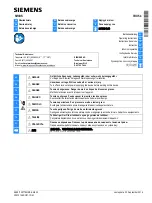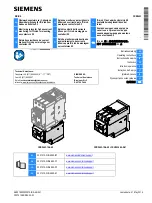
-
6 -
6/07 A1
Run Time
Next Restart
Delay (minutes)
Starts/Hr
> 1Hr
6
10
30 min.- 59.99 min.
15
4
15 min.- 29.99 min.
30
2
< 15 min.
60
1
Table 2
.
: Automatic Dry-Well Recovery Timer
#RU/ADDR
- The #RU/ADDR is a dual-function setting. #RU is displayed when the
DISPLAY/PROGRAM knob is between the 7 o’clock and 11 o’clock position of the dial.
ADDR is displayed above the 11 o’clock position on the DISPLAY/PROGRAM dial.
#RU is the number of restarts the 777-P will attempt after an undercurrent fault before the
unit locks out and requires a manual reset. #RU can be set to 0, 1, 2, 3, 4, or A. This
counter is cleared one minute after restarting if the 777-P does not trip again on
undercurrent.
EXAMPLE: #RU set to 1
If the 777-P trips on undercurrent, restarts automatically (after RD3), then trips again on
undercurrent within one minute, the 777-P will lock out and require a manual reset. On the
other hand, if the 777-P restarts after an undercurrent fault, but runs without tripping on
undercurrent for more than a minute, the unit will not lock out if an undercurrent fault occurs.
If #RU is set to “0,” the 777-P will require manual resetting after all undercurrent faults.
If #RU is set to “A,” the 777-P will always restart automatically after undercurrent faults.
ADDR is the RS-485 address of the 777-P. This is only used when communicating with an
RM-2000, RM-1000, COM-DN, CIO-DN, a PLC, or a PC. The address can be 1–99 (A01–
A99).
#RF
- #RF is the number of restarts the 777-P will attempt after current unbalance or current
single-phase faults. This counter will be cleared one minute after start-up if the unit does not
trip again on a current unbalance, or current single-phase condition (see example for #RU).
Available settings are 0, 1, 2, 3, 4 and A, or to include overcurrent faults in this restart
function, #RF can be set to oc1, oc2, oc3, oc4 or ocA.
If #RF is set to “0,” the 777-P will require manual resetting after all current unbalance,
single-phase and overcurrent faults.
If #RF is set to “A,” the 777-P will always restart automatically after current unbalance and
single-phase faults.
If #RF is set to “ocA,” the 777-P will always restart automatically after current unbalance,
single-phase and overcurrent faults.
UCTD
- UCTD (undercurrent trip delay) is the length of time, in seconds (standard), the unit will
allow the motor to run in an undercurrent situation before de-energizing its relay. Typically,
UCTD is set to 2-4 seconds.
GF
-
GF (ground fault) is the maximum allowable current that can flow to ground before the 777-
P de-energizes its relay. This is a residual, class II ground fault system and should not be
used for personnel safety. A typical setting for GF is 10-20% of motor FLA (in amps). The
GF test procedure in this installation instruction manual must be conducted before the
device is brought online.


































